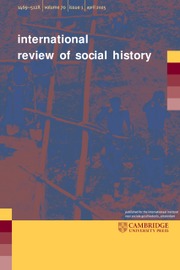This volume is an innovative edited collection that explores the interrelation between memory and social movements across various contexts and time periods. Curated by Stefan Berger, a prominent historian at the Institute for Social Movements at Ruhr-Universität Bochum, and Christian Koller, from the Swiss Social Archives, the book assembles contributions from a varied group of scholars who explore how social movements harness collective memory as a resource in their struggles. It highlights a scholarly interest in the historical paths and conditions of social movements from the modern period onward. The book posits that, while social movements have usually been analysed through the lenses of political change or sociological theory, the role of memory has not received adequate scrutiny until recently. It argues that memory serves as a vital resource for movements, shaping identities, narratives, and strategies in their search for social justice. In an era when social movements play a significant role in political discourse, understanding their relationship to memory provides rich insights into their strategies and impacts. In the wake of the resurgence of historical movements since the late twentieth century, including labour movements, ecological movements, and anti-colonial struggles, the editors posit that memory functions not merely as a static entity but also as a dynamic component that evolves alongside movements (pp. 1–3).
The book comprises thirteen chapters, each investigating different dimensions of memory’s role in social movements. These include the remarkable chapter “Framing the ‘Collective Memory’: The Politics of Mobilisations Against Hydropower Projects in Maharashtra, India (1980–2004)” by Arnab Roy Chowdhury (pp. 19–37), which examines how grassroots organizations in India used collective memory to articulate resistance against state-led hydropower projects, integrating narratives of anti-caste struggles with environmental activism. Another important chapter is “Seeds as a Site for Humanistic Inquiry: Mapping Memory and Movement Through the ‘Sovereign Forest’” by Jawhar Cholakkathodi (pp. 39–53), which explores the interrelation of art and social movements through the lens of an installation that stresses indigenous seeds as active agents of resistance against capitalist appropriation of agriculture. The following chapter, “Constructing the History of Working-Class Neighbourhoods: Communicative and Cognitive Reference to the Past in Conflicts Over Urban Redevelopment in West-German Cities in the 1970s and 1980s” (pp. 55–75), by Sebastian Haumann, investigates how memories of working-class solidarity shaped contemporary resistance against urban redevelopment initiatives in Germany. In general, the book encapsulates the diverse methodological approaches taken by the contributors, from historical analysis and memory studies to cultural history and sociology.
The volume applies an interdisciplinary framework that questions history, sociology, memory studies, and art criticism. By doing so, it stresses how memory functions across different mediums, art installations, public narratives, collective testimonies, and political contexts. For instance, Cholakkathodi uses an object-oriented finding to comprehend how seeds, as material artefacts, include ecological and social movements (pp. 39–53). The section on working-class neighbourhoods (pp. 55–75) showcases a robust interplay between personal narratives and historical structural analysis, aligning with contemporary memory studies that seek to situate individual experiences within wider socio-political frameworks.
This research has many strengths, one of which is its valuable case-study approach, which clarifies different cultural contexts and their specific histories of resistance. The editors successfully foreground the importance of memory in social movements, making a persuasive case for its relevance in both historical scholarship and contemporary activism. For example, the navigation of urban redevelopment in West German cities (pp. 55–75) offers a clear nexus between memory, community identity, and urban policy, demonstrating how collective memory influences the political landscape. Additionally, the book contributes significantly to the historiography of social movements by propagating that understanding memory’s role enables a deeper comprehension of social change and political struggles (pp. 2–3). The diverse methodologies and contributors encourage further interdisciplinary dialogue. Among the chapters, Cholakkathodi’s is distinct due to its innovative approach in using a multimedia installation to emphasize the complexities of memory and resistance in the face of ecological degradation. Similarly, Roy Chowdhury’s contribution concentrates on collective memory in environmental activism in India and redefines the discourse around memory politics in non-Western contexts, making a compelling argument for the significance of local historical narratives in global environmental movements.
There are some weaknesses in this volume. Some chapters risk overwhelming those readers less familiar with memory studies with dense theoretical frameworks. For example, the discourse surrounding communicative and cultural memory may require more precise definitions and contextual grounding (pp. 1–19). Additionally, while most chapters offer compelling arguments, others are void of sufficient empirical evidence to support their claims, potentially undermining the overall impact of their arguments.
This volume fits well within a growing body of literature that seeks to understand the dynamics of memory in social movements. It also revives dialogues about the role of memory in forming collective identities and political agendas, as illustrated in recent explorations of the intersection between memory studies and social activism.
The book’s historiographical significance rests on its commitment to exploring memory as a historical agent rather than merely offering a passive reflection on the past. It argues that memory is crucial for building social movements and political activism, ultimately resulting in our understanding of history as a dynamic interplay of voices and narratives shaped by collective experiences.
This book is aimed at scholars and students interested in history, sociology, memory studies, and cultural studies, as well as activists and practitioners engaged in social movements. It offers rich insights for those exploring the intersection of memory, identity, and activism.
In conclusion, the research presented in this volume is a significant contribution to our understanding of how memory influences social movements and political discourse. The interdisciplinary nature of the collection enhances both its breadth and relevance, while the specific case studies offer substantive insights into the diverse roles memory plays in activism. Ultimately, this volume amplifies the potential of memory to serve as both a resource for protest and a way of cultural preservation, thereby underscoring its prolonged importance in the fabric of social justice movements.


